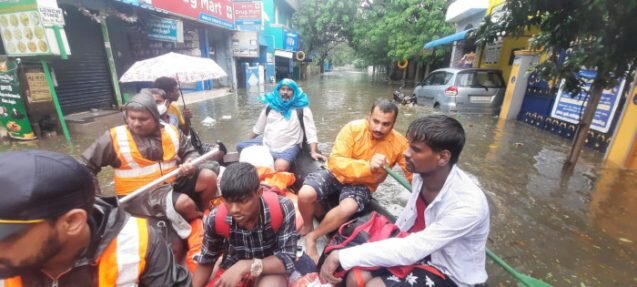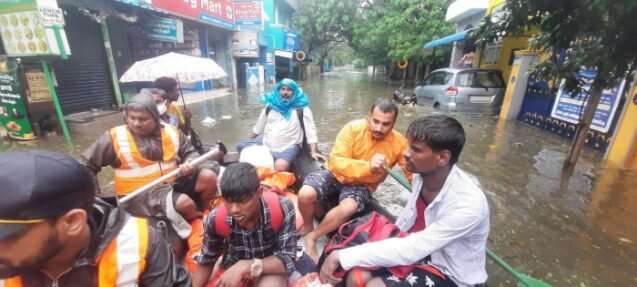

In central and southern China, tens of thousands of people have been forced to evacuate their homes due to flooding from extreme rainfall. The Guardian reports that approximately a million people have seen their homes damaged and lives uprooted from the worst floods in decades.
Meanwhile, CNN reports that in India and Bangladesh, heavy rains have caused flooding and landslides that have devastated communities and killed more than 100 people. The flooding in northeastern Bangladesh has stranded 4 million people, including 1.6 million children, according to UNICEF.
State of the Planet collected comments from several experts from Columbia University’s Climate School to learn more about what meteorological conditions may be behind these tragic disasters, how climate change is contributing to heavier downpours, and how societies can adapt in an increasingly inundated world.
Flooding factors
Mingfang Ting, a research professor at Columbia Climate School’s Lamont-Doherty Earth Observatory, studies precipitation extremes. She pointed to several large-scale climatic conditions that could be contributing to the intense rainfall in China and South Asia:
“I haven’t had a chance to look into the meteorological conditions that led to the downpour, but as we are in the middle of the monsoon season there, it is expected to get a lot of rain at this time of year. The question is, why in such high intensity? La Niña is definitely one culprit here. During La Niña, the ocean is warmer in the western tropical Pacific, or the warm pool region, allowing more abundant warm, moist air to be transported toward southern China when the weather system is aligned. Another potential contributor is the Indian Ocean Dipole, which is in a slightly negative phase at the moment, which also makes the western tropical Pacific warmer than normal.
“The same concept applies to Bangladesh and Northeastern India where flooding is also happening this year. However, the negative phase of the Indian Ocean Dipole is actually suppressing monsoon rainfall in Central India, though La Niña does increase the Indian monsoon rainfall similar to monsoons in China and Bangladesh.”
In addition to these natural climate modes, Ting suggested that China’s recent air quality improvements could also be contributing to the heavy rains, due to a reduction in aerosol particles. Although these particles are harmful to human health,
“Aerosols act to reduce rainfall and make clouds stay in the atmosphere rather than precipitate, so cleaning up the air will have the opposite effect, increasing the intensity of rainfall. In terms of human factors to the rainfall intensity in recent years, the rather successful air quality improvements may have made the flooding more severe in an unexpected way.”
Contributions from climate change?
Kai Kornhuber, who studies extreme weather at Lamont-Doherty Earth Observatory, said that the extreme rainfall and flooding events are in agreement with what scientists expect to see, and are already observing, in a climate-changed world:
“Although the exact meteorological conditions of this particular event will require further investigation, the first order physical relationships between a warmer planet and more extreme rainfall are well understood: as warmer air can hold more moisture, more extreme rainfall is to be expected.
“The current flood events are another sad example of a series of record-breaking precipitation extremes such as the floods in Central Europe and the Hunan Floods of the past year. My colleagues and I describe these events in our recent paper in Nature Urban Sustainability and in a commentary in State of the Planet.”
Coincident concerns
Kornhuber added that it is particularly worrying that extreme weather events like this are increasingly occurring close together in space and time:
“The parts of the areas affected by the current floods already witnessed severe floods in 2021, and happen in near concurrence with the floods in Bangladesh and India and extreme and record-breaking heat in North America, Western Europe, the Middle East and East Asia. Consecutive and concurrent extremes can slow down and inhibit recovery, and can have consequences for supply chains and food security. These impacts can then compound with other unresolved crises, such the Russian War of Aggression in Ukraine and the COVID pandemic.”
Along similar lines, Ting added that Southern China has been experiencing drought conditions in recent years, making matters more complicated:
“This type of extreme swing will make the flooding more dangerous as it can lead to landslides more easily. Any adaptation or solution has to be able to deal with more extreme swings like what we are seeing now, which may not have been in their planning before.”
Economic and supply chain considerations
In 2018, Anders Levermann of the Potsdam Institute for Climate Impact Research and Lamont-Doherty Earth Observatory co-authored a study that found that climate-related flooding not only impacts peoples’ lives, but can also harm economies on a global scale. Through supply shortages, changes in demand and associated price signals, economic losses might be carried downstream along the global trade and supply network, affecting other economies on a global scale
The study projected that China would be hit hardest, with an 80 percent increase in floods, and that the United States might in turn be particularly vulnerable because of its unbalanced trade with China.
Adapting to a more flood-prone world
In a study published this week, Kai Kornhuber and colleagues Mona Hemmati from Lamont-Doherty Earth Observatory and Andrew Kruczkiewicz from Columbia Climate School’s International Research Institute for Climate and Society detail a variety of ways cities can adapt to extreme rainfall.
While climate change is causing heavier downpours, the rapid growth of cities further exacerbates flooding by covering up surfaces that could otherwise absorb rain water. To counteract this effect, the researchers point out that stormwater management systems and green and blue infrastructure are proven to be helpful at controlling runoff. Meanwhile, zoning, land-use regulation, and buyout programs can help to keep people out of flood-prone areas, perhaps making way for parks and green spaces that can absorb water.
Impact-based forecasting and early warning systems can also potentially help to reduce losses and fatalities from flooding in urban communities, the scientists note.
They emphasized that social justice must be central to designing and implementing adaptations to extreme rainfall.
Climate change a factor in ‘unprecedented’ South Asia floods
Earth Institute at Columbia University
This story is republished courtesy of Earth Institute, Columbia University http://blogs.ei.columbia.edu.
Citation:
What’s causing the devastating floods in China, India, and Bangladesh? (2022, June 23)
retrieved 23 June 2022
from https://phys.org/news/2022-06-devastating-china-india-bangladesh.html
This document is subject to copyright. Apart from any fair dealing for the purpose of private study or research, no
part may be reproduced without the written permission. The content is provided for information purposes only.
